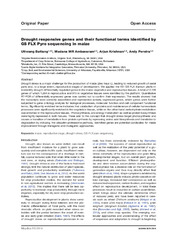| dc.contributor.author | Batlang, Utwang | |
| dc.contributor.author | Ambavaram, Madana MR | |
| dc.contributor.author | Krishnan, Arjun | |
| dc.contributor.author | Pereira, Andy | |
| dc.date.accessioned | 2020-07-08T15:55:40Z | |
| dc.date.accessioned | 2021-03-15T09:19:18Z | |
| dc.date.available | 2020-07-08T15:55:40Z | |
| dc.date.available | 2021-03-15T09:19:18Z | |
| dc.date.issued | 2014 | |
| dc.identifier.citation | Batlang, U. (2016). Drought responsive genes and their functional terms identified by GS FLX Pyro sequencing in maize. Maydica, 59(3), 1-9. | en_US |
| dc.identifier.uri | https://journals-crea.4science.it/index.php/maydica/article/view/1254 | |
| dc.identifier.uri | http://moodle.buan.ac.bw:80/handle/123456789/251 | |
| dc.description.abstract | Drought stress is a major challenge for the production of maize (Zea mays L), leading to reduced growth of aerial parts and, to a large extent, reproductive stages of development. We applied the 454 GS FLX titanium platform to identify drought differentially regulated genes in the maize vegetative and reproductive tissues. A total of 2,199 genes of which 1,284 in reproductive and 915 in vegetative tissues were identified by the platform. Quantitative RT-PCR of differentially expressed genes was carried out to confirm their expression. The results showed that the transcripts were correctly assembled and represented actively expressed genes, which genes were further subjected to gene ontology analysis for biological processes, molecular function and cell component functional terms. Significantly enriched terms indicates that catabolism of proteins and maintenance of cellular homeostasis processes were significantly enriched in the vegetative tissues, while on the other hand carbohydrate metabolism was enriched in the reproductive tissues. Photosynthesis, and energy metabolism as well as protein biosynthesis were highly repressed in both tissues. These add to the concept that drought stress target photosynthesis and causes a transition of metabolism from protein synthesis by repressing amino acid biosynthesis and translation to degradation by inducing the ubiquitin-proteasome pathway. Identified genes are potential candidates for maize improvement through transgenic and mutagenic approaches. | en_US |
| dc.language.iso | en | en_US |
| dc.publisher | Crea Journals | en_US |
| dc.relation.ispartofseries | Maydica;Vol. 59 | |
| dc.subject | Maize | en_US |
| dc.subject | Reproductive stage | en_US |
| dc.subject | Drought stress | en_US |
| dc.subject | GS-FLX pyro-sequencing | en_US |
| dc.title | Drought responsive genes and their functional terms identified by GS FLX Pyro sequencing in maize | en_US |
| dc.type | Article | en_US |

